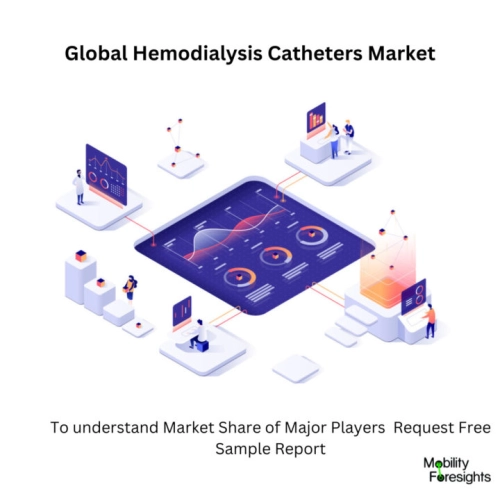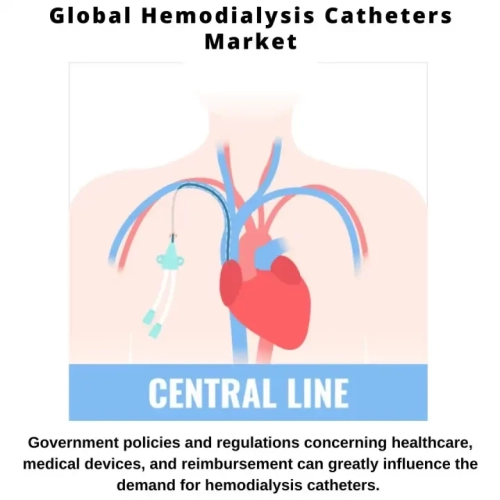
- Get in Touch with Us

Last Updated: Apr 25, 2025 | Study Period: 2024-2030
HDCs (hemodialysis dialysis catheters) are a crucial component of kidney replacement therapy. Despite the fact that these catheters are only meant to serve as a temporary solution until more permanent vascular access procedures like arteriovenous fistulas and grafts are performed, they are linked to high rates of morbidity and death as well as higher medical costs.
Nevertheless, a significant portion of people with end-stage kidney disease begin dialysis with these catheters in spite of these hazards.The invasiveness of HDCs to the venous vascular tree, which results in both mechanical and infectious problems, is what gives rise to their pathogenicity. Because of the widespread use of these catheters in the dialysis population and the resulting difficulties, ongoing advancements in catheter material, design, and placement methods are required.
This study offers an update on the different types of catheters, catheter tip designs, and new technologies and inventions targeted at enhancing catheter functionality and reducing issues associated with it. Despite efforts to reduce the frequency and length of HDC requirements, HDC will still be required for kidney replacement therapy in the majority of ESRD patients. HDC implantation, use, and removal are all fraught with dangers and issues.
The central veins must be accessible for hemodialysis in order to deliver an extracorporeal blood flow rate of more than 300 mL/min for three to four hours, three times per week, with the fewest possible problems. When hemodialysis is urgently required, hemodialysis catheters are appropriate.
A tunnelled hemodialysis catheter should be inserted instead, unless there are concerns about the risk of infection, if the patient will get ongoing outpatient care or if the duration of hemodialysis with a catheter would likely be more than two weeks. Ideally, an AV access can be made if the patient's anatomy and physiology allow it, and once the AV access can be used consistently, the hemodialysis catheter is removed.

The Global hemodialysis catheters market accounted for $XX Billion in 2023 and is anticipated to reach $XX Billion by 2030, registering a CAGR of XX% from 2024 to 2030.
The Arrow-Clark VectorFlow Catheter is a tunnelled, symmetrical-tip hemodialysis catheter created to deliver sustained high flows, lessen lock solution loss, and lessen the chance of thrombus buildup due to platelet activation brought on by shear stress. The catheter is made with a cutting-edge tip that enables placement flexibility with little negative impact on recirculation rates. It is available in both retrograde and antegrade insertion platforms.
The chronic hemodialysis catheter tip by Arrow-Clark is engineered for high performance. It is recommended to utilise the Arrow-Clark VectorFlow Antegrade Catheter to establish long-term vascular access for hemodialysis and apheresis. The internal jugular (IJ) vein is chosen as the preferred location for the percutaneous insertion of the Arrow-Clark VectorFlow Antegrade Catheter.
Although the jugular vein is the ideal location, this catheter can also be put into the subclavian vein. Femoral vein insertion is intended for catheters longer than 40 cm. Adult patients are the target audience for the Arrow-Clark VectorFlow Antegrade Catheter. A New Chronic Hemodialysis Catheter Is Launched by Argon Medical Devices. It has a licence from Rex Medical, LP and is made to give dialysis patients long-term vascular access.
Clinical professionals now have access to UltraStream, a cutting-edge tool that will enhance patient care and quality of life. This innovative technique expands our dialysis platform and demonstrates our dedication to this emerging illness state.
The UltraStream Chronic Hemodialysis catheter is the only Chronic Dialysis catheter on the market with novel dual lumen arterial lines and a modified step tip design that allow for high flow rates and ease of insertion, providing the dual benefits of improved patient outcomes and clinician satisfaction. The insertion of this unique step tip design is possible both over the wire and through a peel-away sheath.
It is simpler to swap catheters thanks to the smooth transition from the dilator to the step tip. For the convenience of doctors, UltraStream catheters are offered in a range of preconfigured configurations. Along with comprehensive lines of PICC and midline catheters, they also sell various vascular items such introducer sheaths, pressure transducers, endomyocardial biopsy forceps, and pressure transducers.
AngioDynamics introduced the central venous catheter for hemodialysis. Its curved ends keep the catheter's ports centred in the superior vena cava (SVC), away from the vein walls, when it is inserted through the catheter's distal end, which has a distinctively curved design. Instead of the atrium, the lower portion of the SVC is where the catheter's tips are put.
Their clinical testing with Centros have led us to believe that their innovative design will provide great, unhindered blood flow for a longer period of time than other, currently available dialysis catheters. Due to the frequent need for interventions to address clots, sheathing, or other issues, patients would benefit from a quicker process and fewer of these. Spire Biomedical's Long Term Hemodialysis Catheter has been successfully introduced to the market, and CFDRC is happy to report this.
This new, fixed-tip hemodialysis catheter offers the highest level of high-efficiency dialysis by combining simplicity of insertion with very little recirculation, outperforming existing catheters significantly. The National Institutes of Health (NIH) first supported the Small Business Innovative Research (SBIR) project under which CFDRC created the catheter.
Spire, CFDRC's commercialization partner, was given a sole licence to use the concept after it was patented by CFDRC. Leading nephrologists and vascular surgeons from throughout the nation have given Spire's product a positive review after the company finished manufacturing and testing it, acquired FDA approval, and finished testing it.
The catheter has been created and optimised using a variety of cutting-edge computer simulations, including computational fluid dynamics (CFD) and coupled fluid-structural interactions, as well as an additional set of experimental studies.
| Company | Product | Year | Description |
| Pristine | Long-Term Hemodialysis Catheter | 2021 | It is a chronic catheter that provides long-term vascular access for hemodialysis, apheresis, and infusion. It has a radiopaque shaft with a pre-formed split tip, two color-coded luer adapters, and clear extension tubes. |
| Nipro Medical Corporation | second generation Cronus HP PTA Balloon Catheter | 2022 | Cronus HP is a high pressure (HP) percutaneous transluminal angioplasty (PTA) balloon catheter indicated for use in popliteal, femoral, iliac, and renal arteries and in the treatment of arteriovenous fistulas (AVF). |
| Medtronics | Muhurkar QPlus | 2023 | It is a high flow dual lumen catheter offers one of the largest internal diameters available on the market to maximize flow rate for acute dialysis patients. This family of high flow dual lumen catheters is indicated for hemodialysis, apheresis and infusion. |

| 1 | Market Segmentation |
| 2 | Scope of the report |
| 3 | Abbreviations |
| 4 | Research Methodology |
| 5 | Executive Summary |
| 6 | Introduction |
| 7 | Insights from Industry stakeholders |
| 8 | Cost breakdown of Product by sub-components and average profit margin |
| 9 | Disruptive innovation in theIndustry |
| 10 | Technology trends in the Industry |
| 11 | Consumer trends in the industry |
| 12 | Recent Production Milestones |
| 13 | Component Manufacturing in US, EU and China |
| 14 | COVID-19 impact on overall market |
| 15 | COVID-19 impact on Production of components |
| 16 | COVID-19 impact on Point of sale |
| 17 | Market Segmentation, Dynamics and Forecast by Geography, 2024-2030 |
| 18 | Market Segmentation, Dynamics and Forecast by Product Type, 2024-2030 |
| 19 | Market Segmentation, Dynamics and Forecast by Application, 2024-2030 |
| 20 | Market Segmentation, Dynamics and Forecast by End use, 2024-2030 |
| 21 | Product installation rate by OEM, 2023 |
| 22 | Incline/Decline in Average B-2-B selling price in past 5 years |
| 23 | Competition from substitute products |
| 24 | Gross margin and average profitability of suppliers |
| 25 | New product development in past 12 months |
| 26 | M&A in past 12 months |
| 27 | Growth strategy of leading players |
| 28 | Market share of vendors, 2023 |
| 29 | Company Profiles |
| 30 | Unmet needs and opportunity for new suppliers |
| 31 | Conclusion |
| 32 | Appendix |